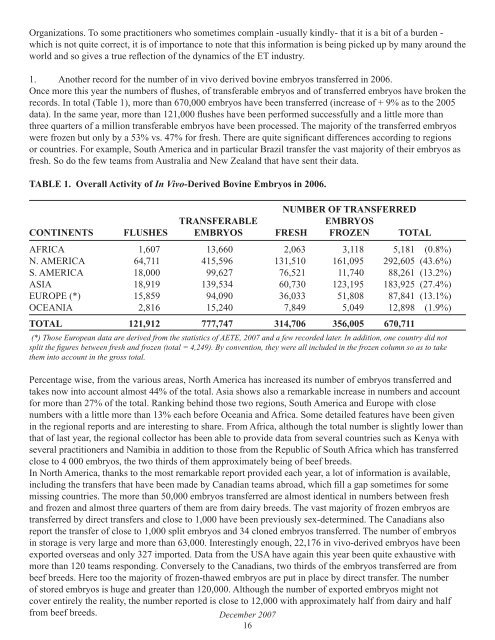December 2007 - International Embryo Transfer Society
December 2007 - International Embryo Transfer Society
December 2007 - International Embryo Transfer Society
You also want an ePaper? Increase the reach of your titles
YUMPU automatically turns print PDFs into web optimized ePapers that Google loves.
Organizations. To some practitioners who sometimes complain -usually kindly- that it is a bit of a burden -<br />
which is not quite correct, it is of importance to note that this information is being picked up by many around the<br />
world and so gives a true reflection of the dynamics of the ET industry.<br />
1. Another record for the number of in vivo derived bovine embryos transferred in 2006.<br />
Once more this year the numbers of flushes, of transferable embryos and of transferred embryos have broken the<br />
records. In total (Table 1), more than 670,000 embryos have been transferred (increase of + 9% as to the 2005<br />
data). In the same year, more than 121,000 flushes have been performed successfully and a little more than<br />
three quarters of a million transferable embryos have been processed. The majority of the transferred embryos<br />
were frozen but only by a 53% vs. 47% for fresh. There are quite significant differences according to regions<br />
or countries. For example, South America and in particular Brazil transfer the vast majority of their embryos as<br />
fresh. So do the few teams from Australia and New Zealand that have sent their data.<br />
TABLE 1. Overall Activity of In Vivo-Derived Bovine <strong>Embryo</strong>s in 2006.<br />
NUMBER OF TRANSFERRED<br />
TRANSFERABLE<br />
EMBRYOS<br />
CONTINENTS FLUSHES EMBRYOS FRESH FROZEN TOTAL<br />
AFRICA 1,607 13,660 2,063 3,118 5,181 (0.8%)<br />
N. AMERICA 64,711 415,596 131,510 161,095 292,605 (43.6%)<br />
S. AMERICA 18,000 99,627 76,521 11,740 88,261 (13.2%)<br />
ASIA 18,919 139,534 60,730 123,195 183,925 (27.4%)<br />
EUROPE (*) 15,859 94,090 36,033 51,808 87,841 (13.1%)<br />
OCEANIA 2,816 15,240 7,849 5,049 12,898 (1.9%)<br />
TOTAL 121,912 777,747 314,706 356,005 670,711<br />
(*) Those European data are derived from the statistics of AETE, <strong>2007</strong> and a few recorded later. In addition, one country did not<br />
split the fi gures between fresh and frozen (total = 4,249). By convention, they were all included in the frozen column so as to take<br />
them into account in the gross total.<br />
Percentage wise, from the various areas, North America has increased its number of embryos transferred and<br />
takes now into account almost 44% of the total. Asia shows also a remarkable increase in numbers and account<br />
for more than 27% of the total. Ranking behind those two regions, South America and Europe with close<br />
numbers with a little more than 13% each before Oceania and Africa. Some detailed features have been given<br />
in the regional reports and are interesting to share. From Africa, although the total number is slightly lower than<br />
that of last year, the regional collector has been able to provide data from several countries such as Kenya with<br />
several practitioners and Namibia in addition to those from the Republic of South Africa which has transferred<br />
close to 4 000 embryos, the two thirds of them approximately being of beef breeds.<br />
In North America, thanks to the most remarkable report provided each year, a lot of information is available,<br />
including the transfers that have been made by Canadian teams abroad, which fill a gap sometimes for some<br />
missing countries. The more than 50,000 embryos transferred are almost identical in numbers between fresh<br />
and frozen and almost three quarters of them are from dairy breeds. The vast majority of frozen embryos are<br />
transferred by direct transfers and close to 1,000 have been previously sex-determined. The Canadians also<br />
report the transfer of close to 1,000 split embryos and 34 cloned embryos transferred. The number of embryos<br />
in storage is very large and more than 63,000. Interestingly enough, 22,176 in vivo-derived embryos have been<br />
exported overseas and only 327 imported. Data from the USA have again this year been quite exhaustive with<br />
more than 120 teams responding. Conversely to the Canadians, two thirds of the embryos transferred are from<br />
beef breeds. Here too the majority of frozen-thawed embryos are put in place by direct transfer. The number<br />
of stored embryos is huge and greater than 120,000. Although the number of exported embryos might not<br />
cover entirely the reality, the number reported is close to 12,000 with approximately half from dairy and half<br />
from beef breeds.<br />
<strong>December</strong> <strong>2007</strong><br />
16
















